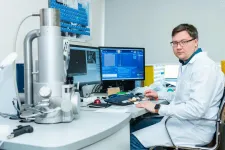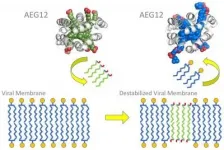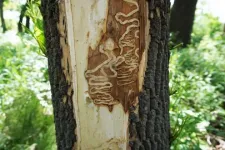Extracting information from ancient teeth
2021-03-10
(Press-News.org) There's a surprising amount of information stored in the hardened plaque, or calculus, between teeth. And if that calculus belongs to the remains of a person who lived in ancient times, the information could reveal new insights about the past. But the tiny samples can be difficult to work with. Now, in ACS' Journal of Proteome Research, scientists apply a new method to this analysis, finding more proteins than traditional approaches.
The human mouth is full of interesting molecules: DNA and enzymes in saliva, proteins and lipids from bits of food stuck between teeth, the bacterial citizens of the oral microbiome. Under the right conditions, those molecules can be preserved in dental calculus for thousands of years. Identifying the biomolecules preserved within ancient plaque gives researchers clues about how our ancestors lived, what they ate, what diseases they had and more. However, there's only so much plaque one can scrape off of old teeth, so it's important to apply methods that can extract the most information from minuscule samples. Although no gold-standard method for calculus analysis exists, filter-based techniques are often used, but they can be time consuming and can introduce contaminants. So, teams led by Michael Buckley and Cheryl Makarewicz wanted to see whether another method, called single-pot, solid-phase-enhanced sample preparation (SP3), could improve the number and complexity of protein fragments that could be analyzed from preserved plaque.
The researchers, led by Karren Palmer, applied SP3 to the analysis of calculus from 153 ancient individuals dating from between the 1st and 4th century BCE. With SP3, functionalized magnetic beads grabbed onto protein fragments, making them easy to analyze by mass spectrometry. The researchers found that SP3 reliably increased the number of unique protein fragments they could identify in samples, including smaller peptides that two other methods, ultrafiltration and acetone precipitation, missed. SP3 was also easy to perform and less likely to introduce contaminants than the other methods. Using this approach, the researchers identified fragments of dairy proteins from the subjects' diets, as well as bacterial proteins that could shed light on ancient diseases.
INFORMATION:
The authors acknowledge funding from the END
ELSE PRESS RELEASES FROM THIS DATE:
2021-03-10
Amsterdam, NL, March 10, 2021 - Music-based interventions have become a core ingredient of effective neurorehabilitation in the past 20 years thanks to the growing body of knowledge. In this END ...
2021-03-10
People are different. New technology is good for patients and the healthcare system. But it could also expand the already significant health disparities in Norway and other countries.
"Women and men with higher education in Norway live five to six years longer than people with that only have lower secondary school education," says Emil Øversveen, a postdoctoral fellow at the Norwegian University of Science and Technology's (NTNU) Department of Sociology and Political Science.
He is affiliated with CHAIN, the Centre for Global Health Inequalities Research. The centre works to reduce social health ...
2021-03-10
In the dry air and soil of Texas' Southern High Plains, improving soil health can be tough. We usually think of healthy soil as moist and loose with lots of organic matter. But this can be hard to achieve in this arid area of Texas.
Lindsey Slaughter, a member of the Soil Science Society of America, set out with her fellow researchers to test a solution that kills two birds with one stone. They put excess cow manure on these soils to see if they could make them healthier.
The team recently published their research in the Soil Science Society of America Journal.
"We know that planting perennial grasslands for cattle production can help protect and restore soil in semi-arid lands that are likely to erode and degrade from intense ...
2021-03-10
The per-capita rates of new COVID-19 cases and COVID-19 deaths were higher in states with Democrat governors in the first months of the pandemic last year, but became much higher in states with Republican governors by mid-summer and through 2020, possibly reflecting COVID-19 policy differences between GOP- and Democrat-led states, according to a study led by researchers at the Johns Hopkins Bloomberg School of Public Health and the Medical University of South Carolina.
For their study, the researchers analyzed data on SARS-CoV-2-positive nasal swab tests, COVID-19 diagnoses, and COVID-19 ...
2021-03-10
Immune cells specialize to ensure the most efficient defense against viruses and other pathogens. Researchers at the University of Basel have shed light on this specialization of T cells and shown that it occurs differently in the context of an acute and a chronic infection. This could be relevant for new approaches against chronic viral infections.
Researchers led by Professor Carolyn King of the University of Basel have developed a method to study the specialization of T cells in the context of infections. In the journal eLife, they report the different directions ...
2021-03-10
The scientists of the National University of Science and Technology "MISIS" (NUST MISIS) being a part of an international team of researches managed to increase the capacity and extend the service life of lithium-ion batteries. According to the researchers, they have synthesized a new nanomaterial that can replace low-efficiency graphite used in lithium-ion batteries today. The results of the research are published in the Journal of Alloys and Compounds.
Lithium-ion batteries are widely used for household appliances from smartphones to electric vehicles. The charge-discharge cycle in such battery is provided by ...
2021-03-10
As plastic debris weathers in aquatic environments, it can shed tiny nanoplastics. Although scientists have a good understanding of how these particles form, they still don't have a good grasp of where all the fragments end up. Now, researchers reporting in ACS' Environmental Science & Technology have shown experimentally that most nanoplastics in estuarine waters can clump, forming larger clusters that either settle or stick to solid objects, instead of floating on into the ocean.
There is a huge discrepancy between the millions of tons of plastic waste entering rivers and streams and the amount researchers have found in the oceans. As large pieces of plastic break apart into ...
2021-03-10
The mosquito protein AEG12 strongly inhibits the family of viruses that cause yellow fever, dengue, West Nile, and Zika and weakly inhibits coronaviruses, according to scientists at the National Institutes of Health (NIH) and their collaborators. The researchers found that AEG12 works by destabilizing the viral envelope, breaking its protective covering. Although the protein does not affect viruses that do not have an envelope, such as those that cause pink eye and bladder infections, the findings could lead to therapeutics against viruses that affect millions of people around the world. The research ...
2021-03-10
Throughout history, leather has been a popular material for clothes and many other goods. However, the tanning process and use of livestock mean that it has a large environmental footprint, leading consumers and manufacturers alike to seek out alternatives. An article in Chemical & Engineering News (C&EN), the weekly newsmagazine of the American Chemical Society, details how sustainable materials are giving traditional leather a run for its money.
Traditional leather goods are known for their durability, flexibility and attractive finish, with a global market worth billions, writes ...
2021-03-10
Since its introduction, the emerald ash borer (EAB) has become the most devastating invasive forest insect in the United States, killing hundreds of millions of ash trees at a cost of hundreds of millions of dollars.
Now, new research from the University of Minnesota's Minnesota Invasive Terrestrial Plants and Pests Center (MITPPC) shows a possible path forward in controlling the invasive pest that threatens Minnesota's nearly one billion ash trees.
In a recent study published in Fungal Biology, MITPPC researchers identified various fungi living in EAB-infested trees -- a critical ...
LAST 30 PRESS RELEASES:
[Press-News.org] Extracting information from ancient teeth




